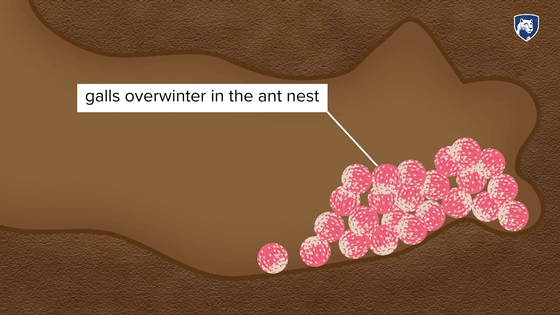An 8-year-old boy contributes to the discovery that overturns `` research on the relationship between insects and plants '' over 100 years

It turned out that the behavior of ants found by an 8-year-old child was a new discovery that led to a review of research on the interaction between insects and plants that had been continuing for more than a century.
Oak Galls Exhibit Ant Dispersal Convergent with Myrmecochorous Seeds | The American Naturalist: Vol 200, No 2
Boy's discovery reveals highly complex plant-insect interaction
https://phys.org/news/2022-09-boy-discovery-reveals-highly-complex.html
◆Beginning of research
The trigger for this new discovery was that 8-year-old Hugo Deans found a small sphere rolling near an ant nest in his backyard. Hugo thought it was a plant seed, but Hugo's father, Andrew Deans, realized it was an oak tree gall .

by
Insect galls are bumps formed when insects and other creatures enter plants, and they are also called 'mushiei.' The galls that Hugo found were galls formed when bees of the family Bumblebee laid their eggs on the leaves of oak trees.
When he made the discovery, Hugo said, ``I didn't know that ants collect plant seeds, so I was excited when I thought the ball I found was a seed, but my father called it a gall. I was even more excited when he told me that I was surprised, 'Why do ants collect gall'?'
Why do ants bring galls back to their nests?
Hugo's question was also a mystery to Mr. Deans, an entomology professor at Pennsylvania State University. Therefore, Deans et al.'s research team started a series of studies to find out why ants collect bugs. First, in the first experiment to observe the behavior of ants that found a gall, it was confirmed that the ant carried the gall to the nest, confirming that the gall did not accidentally fall near the ant's nest. was given.
This yellow object is a gall. The ant held the cap-like part of the gall in its jaws and brought it back to the nest.

The bugs carried by ants had cap-shaped objects, but the caps were removed from the bugs found in the ant's nest. Therefore, the research team named this cap `` kapéllo '', which means `` hat '' in Greek. We hypothesized that Capello was involved in ant behavior and conducted further experiments.
In this experiment, we gave ants ``whole galls'', ``galls with capello removed'', and ``capello alone'' to see which one they were interested in. As a result, ants were interested in the entire gall and capello, but indifferent to the gall body without capello. This confirms that the ants collected the galls in order to peel off the capello from the galls and eat them.
As mentioned above, the galls carried by the ants are galls produced by the eggs of the bee. Therefore, it is speculated that the behavior of the ants observed this time may be a clever strategy of the bumblebee to protect the larvae by transporting galls to the ant's nest.
The specific mechanism is explained in an easy-to-understand manner in the following movie.
First, in the summer, bees lay their eggs on the leaves of trees.

Then, when the eggs turn into larvae, galls with capello are formed.

Galls fall to the ground in autumn and are eaten by birds and mice.

But before that, the ants bring the gall back to the nest.

The ants that brought back the gall will eat the nutritious Capello.

After eating the capello, the galls are left in the nest. In this way, the strategy of the bee proposed by the research team is that the larvae of the bee can safely pass the winter while being protected from external enemies and mold.

◆What is amazing about this discovery?
It has long been known that some plants, including those of the
However, it was found that capello, which the research team discovered this time, is rich in nutrients such as fatty acids, just like elaiosomes. According to the research team, these findings may lead to discussions among scholars as to whether ``the elaiosome is first or the bug is first.''
'Given that ant spraying was first documented over 100 years ago and has been studied and taught in schools since then,' said study team member Robert J. Warren of the State University of New York. , it is tempting to think that the elaiosome comes first, but this assumption may be wrong for several reasons.'

by Jeff delonge
One reason for this is that galls are more common in nature than elaiosomes. Plants that disperse ants are a small part of the whole plant, so it is possible that they do not have enough influence to acquire the habit of bringing back seeds. It is said that insect galls were useful as livestock feed.
From this, the research team stated in the paper, ``Ant-mediated seed dispersal and gall dispersal show a strong convergence, and galls are seeds with elaiosomes in deciduous forests in eastern North America. existing ant and plant studies will need to be reconsidered, as they are much more abundant.'
Regarding contributing to this discovery, Hugo, who was 10 years old at the time of writing the article, said, ``I am really happy and proud that I was able to take part in an important scientific discovery.Ant collects seeds. It's a strange feeling that when you think you've found something, it's actually a scientifically important discovery.' In addition, Hugo answered 'not so much' to the question 'Do you want to be an entomologist like your father when you grow up?'
Related Posts:







